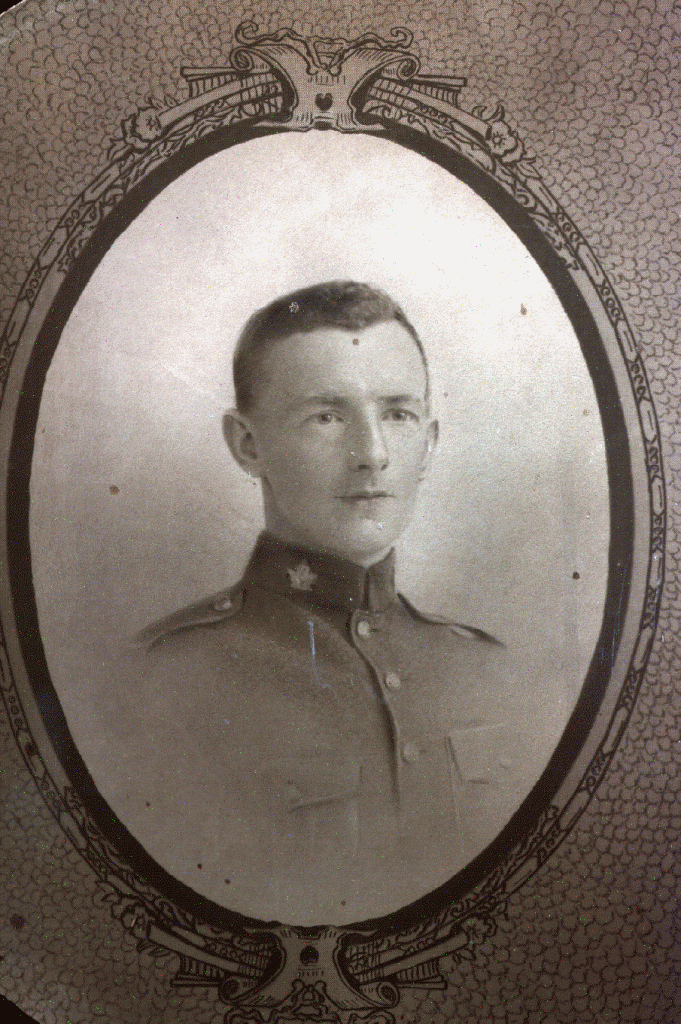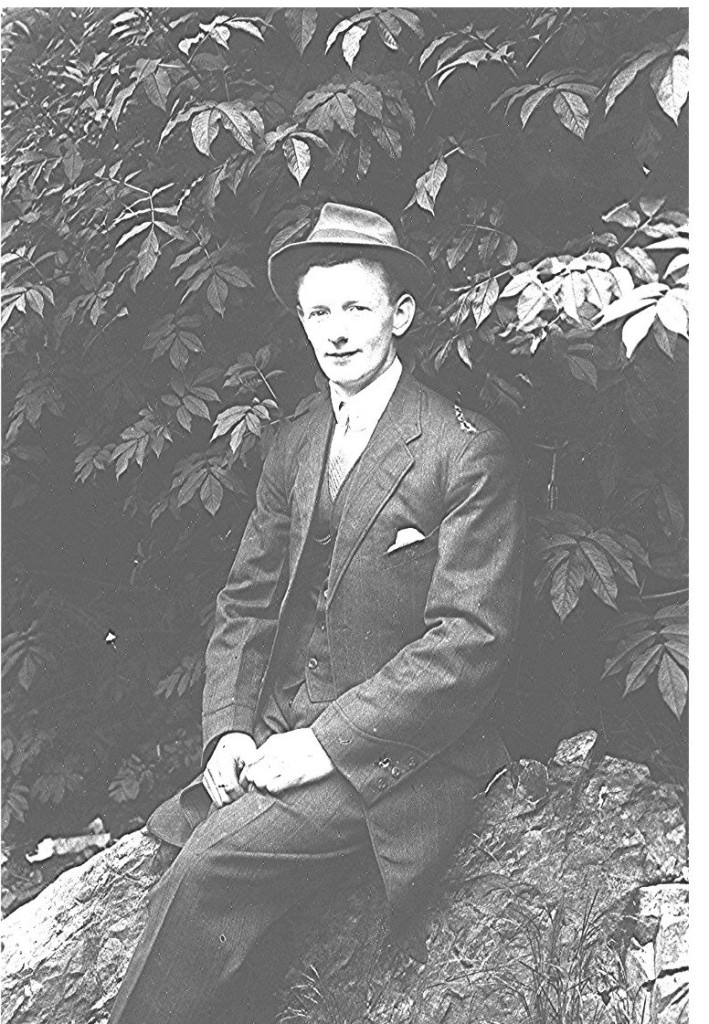
“Bravery, grit, determination and endurance.” Joseph Harold Grice of Tofino showed all these qualities in his war service as a Pioneer, doing the vital – and dangerous – work of building trenches, roads and dug-outs for major campaigns in the Somme and the Ypres Salient. Joe was lost at Passchendaele on November 6 1917.
Joseph Harold (“Joe”) Grice was born on December 30 1890, Newcastle Upon Tyne, England to John and Jane Grice. When war was declared in 1914, Joe was living in Tofino with his family. His dad John Grice was (among other things) justice of the peace, master customs officer and fisheries overseer. His brother Arthur (“Curley”) worked as a cook at Clayoquot on Stubbs Island. A notice in the Victoria Daily Times dated October 29 1914 shows the Grice family supporting the local Patriotic Fund for families of Clayoquot Sound residents who had enlisted. (John Grice subscribed $10, Jos. H. Grice $5 and A.J. Grice $5)
At the beginning of April 1915, Joe enlisted with the 88th Victoria Fusiliers, but soon transferred to the 48th Canadian Infantry Battalion, a “British Columbia Battalion.” As he was in training, he couldn’t attend his sister Jenny’s May 1915 marriage to Jack Macleod of the Tofino Lifeboat.
When Joe enlisted, he gave his occupation as “farmer”. However, directories for Tofino for 1914 and 1915 list Grice J H as a “clerk”. Joe’s great-nephew Ron Macleod, who has researched the family history, does not remember any references to farming by him or his father John. It looks more like the Grices dabbled in land development, as did many west coast settlers of that time. Ron Macleod notes: “Registration of pre-emptions shows Curley, Joe, and John Grice actively pursued opportunities and had several applications in the system at one time awaiting cancellation or processing as they saw fit.”

On January 25 1916, the 48th Canadian Infantry Battalion was re-designated the 3rd Canadian Pioneer Battalion. Pioneer battalions worked in the forward area in conjunction with the engineers. The pioneers were involved in these jobs: tunnelling, mining, wiring, railroad work, deep dugout building, and keeping trenches in repair. Joe probably joined a Pioneer battalion because he had previous experience in construction and road building. When the 1911 Canada Census was taken, Joe was working for the Dominion Government, building the Pachena Trail near Bamfield.

On March 9 1916, Joe arrived in Boulogne, France. A few days later he was in the deadly Ypres Salient. The official War Diary for the 3rd Canadian Pioneers vividly describes the conditions. On Wednesday, March 15, 1916, “the enemy put a little shrapnel over in the morning.” In the afternoon, the enemy was active with rifle grenades. That night, “two men were wounded while on working parties – one slightly and one severely in chest with rifle bullet.” This was the Pioneers’ very first day on active service!
All spring 1916, the Pioneers were busy constructing trenches and were almost constantly under enemy fire. On June 19 1916, Major General L.J. Lipsett, Commander of the 3rd Canadian Division asked the O.C. of the 3rd Canadian Pioneer Battalion to convey “his sincere appreciation and thanks for the good work they have been doing for the past three months and particularly during the severe fighting since the 2nd. He stated that the Battalion’s splendid courage and devotion to duty have been commented on. He deeply regretted our losses though they were not made in vain.”
Joe continued to work hard, but by August had become ill. On August 14 1916, Joe was admitted to the No. 9 Canadian Field Ambulance with P.U.O – Pyrexia (fever) of Unknown Origin. Joe recuperated for 3 days, then went back to building trenches. In early September, Joe left the Ypres Salient and moved near Arras France, where he would be for the next 12 months. In late September, Joe met a West Coast neighbour, Corporal Murdo Macleod of the 1st Canadian Pioneers. (Read more about Murdo’s story here.)
On May 17 1917, the 3rd Canadian Pioneer Battalion was disbanded. Major-General L.J. Lipsett addressed Joe and the men. He told them the 3rd Canadian Pioneer had gained for itself the reputation of being one of the finest pioneer battalions in France. “No place had been too hot for them and they had proved not only capable of handling their allotted tasks but had performed them in such a satisfactory and workmanlike manner as to make their work especially noticeable.” (as quoted in the official War Diary)
Joe was transferred to the 29th (Vancouver) Infantry Battalion. At the beginning of August 1917, Joe was granted 10 days leave. He returned to England and married Mary Hall Baker from Newcastle upon Tyne. It was to be a short marriage.

By the end of October, Joe was back at the Ypres Salient, where he had started his active service. On October 25 1917, Joe and the men had foot inspection and foot bath parades. Over the next few days, there were company parades, bayonet fighting and Lewis Gun training. The 29th Battalion moved closer to the battlefront. On November 6 1917, the Canadian Corps successfully captured Passchendaele village. Here is the rather terse 29th Battalion War Diary entry for November 6 1917: “Weather generally fine. Showery during morning…Casualties: Other Ranks: Killed 21, Wounded 79, Missing 8.” Pte. Joseph Harold Grice was one of the men who was killed in action that day.
Joseph Harold Grice’s name is carved in the Menin Gate in Ypres. The Commonwealth War Graves Commission explains: “Individuals are commemorated in this way when their loss has been officially declared by their relevant service but there is no known burial for the individual, or in circumstances where graves cannot be individually marked….” Joe was one of the thousands of men who were victims of the shelling attacks and fell down in the mud of Flanders, his body not be recovered. All we can hope is that Joe is resting somewhere “in Flanders Fields.” Later, Joe’s name was carved on the memorial plaque in Tofino’s Royal Canadian Legion, Clayoquot Sound Branch Number #65. Finally, Joe’s sister Jenny named her son Joseph Harold Macleod in his memory.

Sources from the official War Diaries and Joseph Harold Grice military service files, Library and Archives Canada. Photographs shared by Joe’s great nephew Ron Macleod.